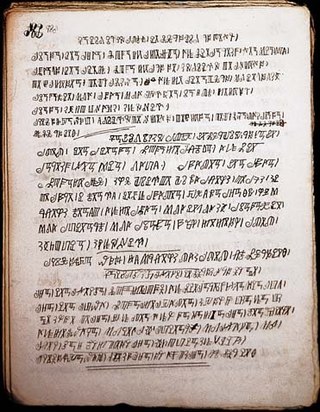Bamum language
| Bamum | |
|---|---|
| Shüpamom | |
| ꛀꛣꚧꚳ | |
| Region | Cameroon,Nigeria |
| Ethnicity | Bamum people |
Native speakers | 420,000 (2005)[1] |
| Dialects |
|
| Latin script,Bamum syllabary(being revived) | |
| Language codes | |
| ISO 639-3 | bax |
| Glottolog | bamu1253 |
 Page from a manuscript in theBamum script | |
Bamum(Shü Pamom[ʃŷpǎˑmə̀m]'language of the Bamum',orShümom'Mum language'), also known asShupamem,Bamun,orBamoun,is anEastern Grassfields languageofCameroon,with approximately 420,000 speakers.[1]The language is well known for itsoriginal scriptdeveloped byKing Njoyaand his palace circle in theKingdom of Bamumaround 1895. Cameroonian musicianClaude Ndamwas a native speaker of the language and sang it in his music.[2]
Phonology
[edit]Bamum hastone,vowel length, diphthongs andcodaconsonants.
Vowels
[edit]Nchare claims ten diphthongs, only eight of which (excluding/ɔ/and/o/) have a length distinction.[3]Matateyou shows normal and long examples of all ten vowel qualities. The orthography in angle brackets was based on theGeneral Alphabet of Cameroon Languagesas used by Matateyou.[4]
| Front | Central | Back | |||
|---|---|---|---|---|---|
| Unrounded | Rounded | Unrounded | Unrounded | Rounded | |
| Close | i⟨i⟩iː⟨ii⟩ | y⟨ü⟩yː⟨üü⟩ | ɯ⟨ʉ⟩ɯː⟨ʉʉ⟩ | u⟨u⟩uː⟨uu⟩ | |
| Mid | e⟨e⟩eː⟨ee⟩ | ə⟨ə⟩əː⟨əə⟩ | o⟨o⟩oː⟨oo⟩ | ||
| Open-mid | ɛ⟨ɛ⟩ɛː⟨ɛɛ⟩ | ɔ⟨ɔ⟩ɔː⟨ɔɔ⟩ | |||
| Open | a⟨a⟩a⟨aa⟩ | ||||
Consonants
[edit]The consonants are displayed as following:[5][4]
| Labial | Alveolar | Palatal | Velar | Labial- velar |
Glottal | ||||
|---|---|---|---|---|---|---|---|---|---|
| Plosive | Plain | Voiceless | p⟨p⟩ | t⟨t⟩ | k⟨k⟩ | k͡p⟨kp⟩ | ʔ⟨ʼ⟩[a] | ||
| Voiced | b⟨b⟩[b] | d⟨d⟩[c] | ɡ⟨g⟩[d] | g͡b⟨gb⟩ | |||||
| Prenasal | Voiceless | ᵐp⟨mp⟩ | ⁿt⟨nt⟩ | ᵑk⟨ŋk⟩ | ᵑ͡ᵐk͡p⟨ŋkp⟩ | ||||
| Voiced | ᵐb⟨mb⟩ | ⁿd⟨nd⟩ | ᵑɡ⟨ŋg⟩ | ᵑ͡ᵐg͡b⟨ŋgb⟩ | |||||
| Fricative | Plain | Voiceless | f⟨f⟩ | s⟨s⟩ | ʃ⟨sh⟩ | ||||
| Voiced | β[b]⟨ɓ⟩[e] | v⟨v⟩ | z⟨z⟩[f] | ʒ⟨j⟩[g] | ɣ⟨gh⟩ | ||||
| Prenasal | Voiceless | ᶬf⟨mf⟩ | ⁿs⟨ns⟩ | ᶮʃ⟨nsh⟩ | |||||
| Voiced | ᶬv⟨mv⟩ | ⁿz⟨nz⟩ | ᶮʒ⟨nzh⟩ | ||||||
| Nasal | m⟨m⟩ | n⟨n⟩ | ɲ⟨ny⟩ | ŋ⟨ŋ⟩ | ŋ͡m⟨ŋm⟩ | ||||
| Rhotic | r⟨r⟩ | ||||||||
| Approximant | Plain | l⟨l⟩ | j⟨y⟩ | w⟨w⟩ | |||||
| Prenasal | ⁿj⟨nj⟩ | ⁿw⟨nw⟩ | |||||||
Tones
[edit]Bamum has four[6]or five tones.[7]Mateteyou's analysis includes a mid tone, while Nchare's analysis includesdownstep.[6]Bamum distinguishes betweenlexical and grammatical tone.[8]
| Diacritic | Nchare | Matateyou |
|---|---|---|
| à | low | low |
| á | high | high |
| ā | ― | mid |
| ǎ | rising | rising |
| â | falling | falling |
| ꜜ | downstep | ― |
References
[edit]- ^abBamumatEthnologue(18th ed., 2015)(subscription required)
- ^Kell, Cathy (14 September 2005)."Cameroon: Claude Ndam: Committed To Culture".Cameroon Tribune.Archived fromthe originalon 2012-07-28.Retrieved28 August2015– via AllAfrica.
- ^Nchare 2012,pp. 39–40.
- ^abMatateyou 2002,pp. 37–38.
- ^Nchare 2012,pp. 44, 46.
- ^abNchare 2012,p. 63.
- ^Matateyou 2002,p. 38.
- ^Nchare 2012,p. 64.
Bibliography
[edit]- Matateyou, Emmanuel (2002).Parlons Bamoun.Paris: L'Harmattan. p. 38.
- Nchare, Abdoulaye Laziz (2012).The Grammar of Shupamem(PhD dissertation). New York University.ProQuest996252918.
- Pawou Molu, Solange (2018).Problèmes de morphophonologie nominale en Bamun-Shüpamom(PhD dissertation). Paris Cité University.
Further reading
[edit]- Bamum Scripts and Archives Project; Riley, Charles (2006-01-08).Towards the Encoding of the Bamum Script in the UCS(PDF)(Report).
